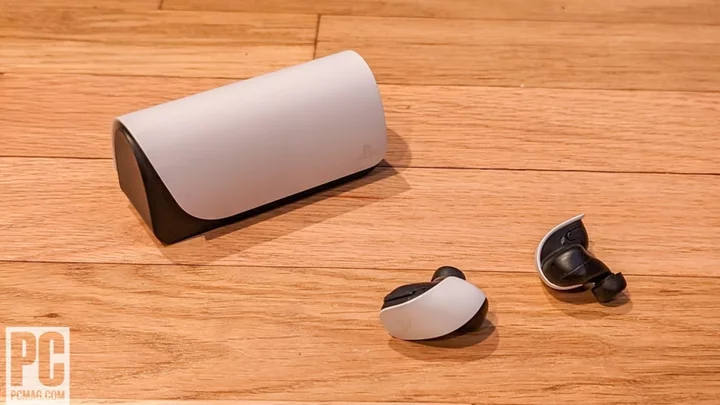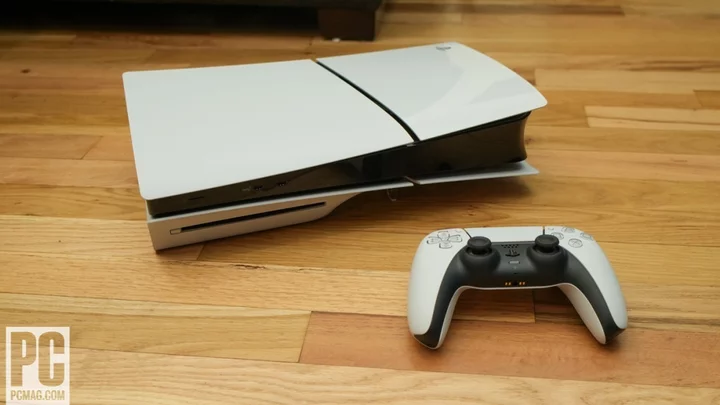Sony's PlayStation Pulse Explore true wireless earphones are designed to be used with your PlayStation 5 or PC through an included USB adapter or with your phone via Bluetooth. From an audio standpoint, they feature planar magnetic drivers that are capable of producing crisp, detailed sound. Unfortunately, their awkward shape and flimsy eartips result in an inconsistent fit and, with it, inconsistent sound. So even considering their advanced driver technology, the Pulse Explore earphones simply aren't worth $199.99. For the same price, you can get both the $99.99 Anker SoundCore Liberty 4 NC earphones, which sound very good, are more comfortable and secure, and feature active noise cancellation, plus a Razer Blackshark V2 ($99.99) headset for gaming.
A Problematic Design
The Pulse Explore earphones certainly have a PlayStation 5 flair, for better or (mostly) worse. Each earpiece is black and white, with a fairly large, curved white panel that wraps up and forward from the rounded black body. It matches the console it’s meant to pair with, and looks quite different from most other true wireless earphones.
Different isn’t always better, though, and the big tabs that jut up from the earphones make it hard to comfortably place them in your ears. A tiny PlayStation logo helps indicate how each earpiece should be oriented, but you have to use that positional reference by memory because you can’t see it when you’re actually inserting the earbud. The upper corner of the tab should point straight up, but because the earpiece body and the eartip are almost circular and have no fins or nubs, it’s very easy to put them in at the wrong angle. This will result in a poor fit and can make the thin silicone eartips uncomfortably flip up.
(Credit: Will Greenwald)This is exacerbated by the fact that all four pairs of included eartips are very thin. The silicone eartips on my Jabra Elite 7 Pro are almost twice as thick, and much less prone to flipping inside out. It took me a while to get used to how to put the earphones in, and I still often have to reinsert them so the eartips don’t flip into my ear.
Then there are the controls, which might as well not be there. The top of both earpieces hold very thin, flat volume rockers with a tiny nub to indicate where they are, and pairing buttons opposite them on the bottom. I have several gripes about the volume rockers, which are difficult to reach, operate separately from the connected device (so they won't change the volume on your phone, as most competitors do), and have no distinct tone for when the volume is maxed out. These small frustrations add up to me not wanting to use the volume rockers at all. Meanwhile, instead of a multifunction button for controlling playback, you only get a pairing button on each earpiece. A press and hold of either button switches the Pulse Explore between the currently connected device and the last device it paired with (typically between your phone and whatever the USB adapter is plugged into). It’s an important button if you want to use the earphones with both your phone and your PS5 or PC, but not necessary to be on both earphones. Instead, at least one could have had playback controls.
The charging case is massive, measuring 1.7 by 3.4 by 1.6 inches (HWD). It’s also black and white, with a black body and a sliding white panel that curves over the front, top, and back. Slide the panel left to reveal the recesses for the earphones and a pairing button. A status light bar runs along the front edge of the case, and a USB-C port for charging sits on the right side. While the case is uncomfortably large to tuck in your pants pocket, the sliding panel at least provides some security smaller, flip-top earphone cases don’t. Whenever I accidentally dropped the case, the earphones stayed in place and didn’t fly out.
Limited Battery and Connectivity
Despite its size, the charging case doesn’t offer storage space for the included PlayStation Link adapter, a simple rectangular USB-A dongle for your PC or PS5 that enables what Sony promises to be lossless, low-latency audio from those devices. Since the case is already as big as it is, a slot to fit the adapter seems obvious, so its absence is disappointing.
(Credit: Will Greenwald)Unlike Sony's non-PlayStation earphones such as the excellent WF-1000XM5 ($299.99), there is no companion app for your phone. This means there are no EQ adjustments available.
The earphones promise up to five hours of battery life on a charge, and the case holds another 10 hours of power. This is pretty anemic for modern true wireless earphones; the Sony WH-1000XM5 can last up to 12 hours with another 24 in the case.
If the awkward fit and controls didn’t already make it clear, the lack of an IP rating shows that these are earphones to use at the gym. They’re not water resistant in any way, and you shouldn’t test them with sweat. They also don't feature any form of noise cancellation, which you typically find in this price range.
Crisp Highs and Lacking Bass
Planar magnetic drivers rely on surface area even more than the cone drivers used in headphones and speakers, which is why earphones that use them, like the Audeze Euclid ($999.99), can get very expensive. The prospect of planar magnetic drivers in a $199.99 pair of earphones is very promising, and here you get full, detailed sound with plenty of treble presence and notably less powerful bass that fortunately doesn’t completely disappear. The highs-weighted signature is great if that’s your taste, but bass lovers who want some thump will be disappointed, as will audiophiles who prefer an even, flat response.
(Credit: Will Greenwald)When playing our bass test track, The Knife’s “Silent Shout,” the drum hits and bass synth notes get some solid low-frequency presence that doesn’t come close to palpable thump, but at least gives the impression of a nicely rounded beat. This is a pleasant surprise because planar magnetic drivers generally excel at detail in the higher frequencies, but tend to be weaker with bass.
Yes’ “Roundabout” sounds excellent on the Pulse Explore. The opening acoustic guitar plucks get plenty of detail in the higher frequencies and good resonance in the lower frequencies. When the track properly kicks in, every element gets a strong presence. The cymbals and guitar strums cut through the mix with a clear edge; the bassline is just punchy enough to anchor the low end; and the vocals sit, clean and prominent, in the center. Here the treble definitely stands out more than anything else while the bass settles further back in the mix, but not so much that the low-end sounds neglected.
Games also sound very good on the Pulse Explore, but the PlayStation 5’s Tempest 3D spatial audio feature doesn’t come through well. When playing Spider-Man 2, I can clearly hear everything from crisp web shots to hard punches to the sweeping score. Deeper effects don’t get a thunderous response, but they’re at least present. For all the sound effects, I get very little sense of directionality in the game. Whether following distant voices or surrounded by thugs, the soundscape doesn’t feel much deeper than a good stereo mix. Earphones tend to offer worse spatial audio directionality than headphones, even with good processing (which the PS5 certainly has), and that’s unfortunately the case with the Pulse Explore.
The Pulse Explore’s microphones are good compared with most other true wireless earphones. It’s almost impossible to get a natural sound through pinhole mics aimed at your mouth from your ears, but my voice sounded clear in test recordings. I noted a bit of echoey distance, but not so much that I sounded muffled or too far away to comfortably hear.
Disappointing by Design
The PlayStation Pulse Explore earphones don't live up to the potential of their underlying technology mostly due to their design. They feel awkward and uncomfortable, and maintaining a consistent fit to get the most out of the planar magnetic drivers is a challenge. Moreover, their battery life is short and they lack basic controls for use with a phone. It might be a different story if they offered an audiophile-pleasing balance, effective active noise cancellation, or any other perk to justify their $200 price, but that’s not the case.
Your best bet for strong audio that covers both music on your phone and gaming on your PS5 is to get a pair of Bluetooth earphones like the Anker Soundcore Liberty 4 NC for music through your phone, and a 3.5mm wired headset like the Razer Blackshark V2 for plugging into your DualSense gamepad. Both earned our Editors’ Choice award and together cost as much as the Pulse Explore. If you really want in-ear earphones you can use with both your phone and your console, meanwhile, check out the $99.99 Anker Soundcore VR P10 for better overall performance than the Pulse Explore at half the price.









